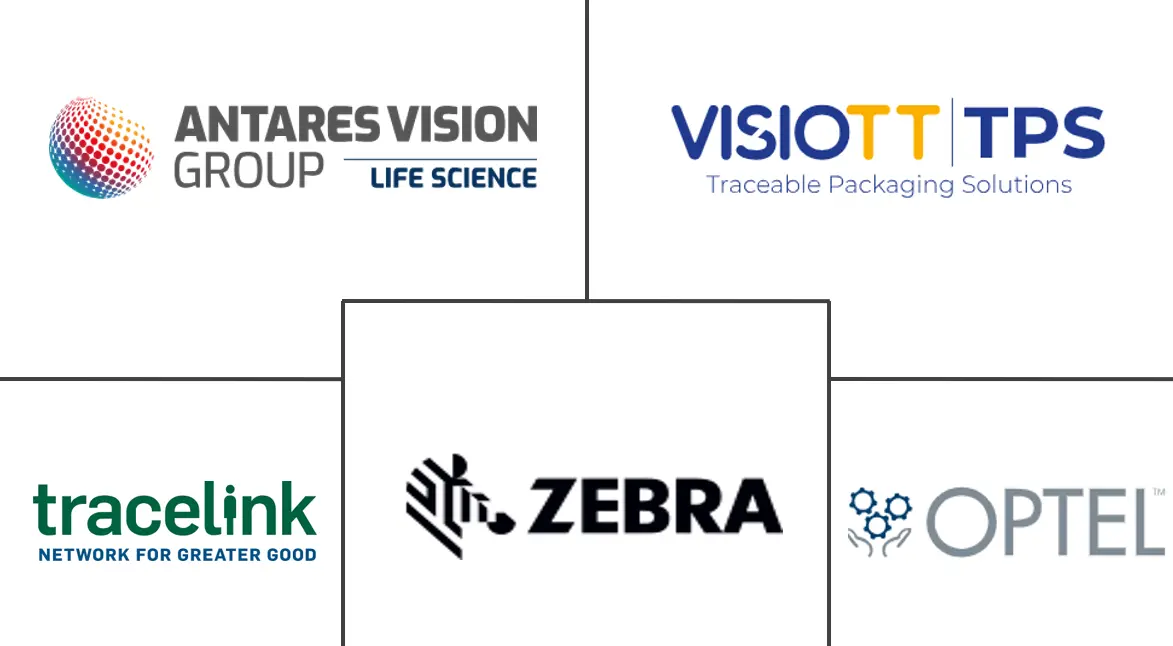Track And Trace Solutions Market Size and Share
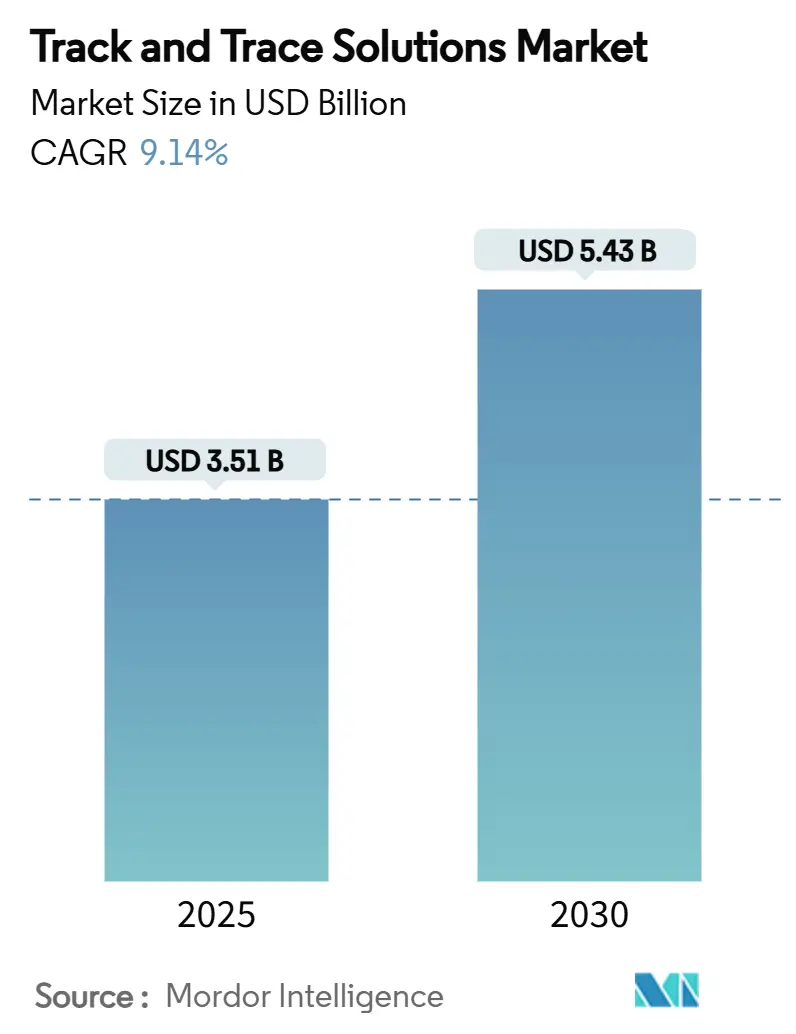
Track And Trace Solutions Market Analysis by Mordor Intelligence
The track & trace solutions market is valued at USD 3.51 billion in 2025 and is projected to reach USD 5.43 billion by 2030, translating into a 9.14% compound annual growth rate (CAGR). Heightened regulatory pressure across pharmaceutical supply chains is turning serialization from a compliance chore into a strategic differentiator, prompting companies to invest in more sophisticated, data-rich platforms. As serialization and aggregation converge on cloud architectures, vendors are eyeing fresh data-monetization avenues while simultaneously confronting new cybersecurity risks. Meanwhile, the Track & Trace Solutions market share of smaller niche vendors is expanding in emerging regions because modular cloud architecture allows them to compete without a global sales footprint.
Key Report Takeaways
- By component, software held 52.64% of the 2024 track and trace solutions market share, while professional & managed services are projected to advance at a 10.49% CAGR through 2030.
- By technology, barcode / 2-D DataMatrix dominated with 55.76% share in 2024, whereas RFID & NFC is forecast to expand at a 9.90% CAGR over 2025-2030.
- By application, serialization solutions accounted for 58.34% of track and trace solutions market size in 2024, while aggregation solutions are set to grow at a 9.77% CAGR during the forecast period.
- By end user, pharmaceutical manufacturers commanded 40.09% share in 2024, whereas healthcare distributors & wholesalers are expected to post a 10.15% CAGR through 2030.
- By geography, North America led with a 42.24% share in 2024, while Asia-Pacific is anticipated to register the fastest growth at a 10.29% CAGR between 2025 and 2030.
Global Track And Trace Solutions Market Trends and Insights
Drivers Impact Analysis
| Driver | (~) % Impact on CAGR Forecast | Geographic Relevance | Impact Timeline |
|---|---|---|---|
| Convergence of Global Pharmaceutical Traceability Mandates (WHO, ISO) | +2.5% | Global, with strongest effect in North America and Europe | Medium term (3-4 years) |
| Escalating Counterfeit Drug Threat Elevating Patient‐Safety Imperatives | +2.0% | Global, with particular impact in Asia-Pacific and Africa | Long term (≥ 5 years) |
| Surge in Direct-to-Patient & E-commerce Channels Requiring End-to-End Visibility | +1.5% | North America, Europe, urban centers in Asia-Pacific | Short term (≤ 2 years) |
| Digitalization of Pharma Supply Chains and Cloud-native SaaS Adoption | +2.2% | Global, with early adoption in North America and Europe | Medium term (3-4 years) |
| Transition to Personalized & Small-Batch Therapies Necessitating Flexible Serialization | +1.0% | North America, Europe, advanced healthcare markets in Asia | Long term (≥ 5 years) |
| Brand Reputation & Recall Cost Avoidance Driving Investment in Track & Trace Analytics | +1.8% | Global, with highest impact in mature pharmaceutical markets | Medium term (3-4 years) |
| Source: Mordor Intelligence | |||
Convergence of Global Pharmaceutical Traceability Mandates
Momentum toward harmonized standards is compelling firms to design systems that satisfy multiple jurisdictions in a single deployment. Vendors therefore invest heavily in flexible data models that map country codes to a common core, which quietly reduces lifetime integration costs for multinational plants. One evident consequence is that manufacturers now issue global requests for proposal instead of region-specific tenders, concentrating purchasing power and accelerating vendor consolidation. This regulatory convergence simultaneously shortens rollout cycles because configuration replaces custom coding, allowing quicker payback periods and freeing budgets for advanced analytics.
Escalating Counterfeit Drug Threat Elevating Patient-Safety Imperatives
The rising sophistication of counterfeit networks forces brand owners to look beyond serialization and adopt multi-layer security that joins tamper-evident packaging, authentication algorithms, and real-time verification portals. By embedding unique identifiers inside layered packaging, companies are discouraging illicit repackaging, a fresh deterrent that also minimizes recall scope when an incident occurs. Health agencies publicly link counterfeit suppression to improved therapy adherence, which drives political endorsement of stricter serialization audits. As a direct result, solution vendors report an uptick in demand for mobile inspection apps that allow frontline staff to validate codes at every hand-off.
Surge in Direct-to-Patient and E-commerce Channels Requiring End-to-End Visibility
Home-delivery models expand the distance between factory and patient, making last-mile authentication unavoidable for brand protection. Supply-chain managers now combine GPS-enabled data loggers with cloud traceability platforms, creating a continuous audit trail that spans warehouses, couriers, and patients’ doorsteps. The same data stream feeds inventory algorithms that forecast micro-fulfillment needs, a feature that aligns with the pharmaceutical industry’s pivot to personalized therapies. Retail pharmacists notice that real-time pedigree checks at the point of dispense increase consumer trust, indirectly boosting refill rates.
Digitalization of Pharma Supply Chains and Cloud-Native SaaS Adoption
Software-as-a-Service deployments cut validation times, turning compliance from a multi-year capital program into a phased operating expense. Vendors leverage multi-tenant architectures to push simultaneous upgrades, ensuring that every customer remains aligned with evolving rule sets, a benefit that old on-premise systems cannot match. A further observation is that aggregated anonymized data feeds machine-learning models that highlight systemic bottlenecks, enabling cross-industry benchmarks unavailable to any single firm. This feedback loop elevates the perceived value of subscription tiers that bundle predictive analytics, sustaining double-digit software growth even as hardware demand matures[1]Shabbir Dahod, “2025 Supply Chain Predictions: Insights from TraceLink’s CEO,” TraceLink, tracelink.com.
Restraints Impact Analysis
| Restraint | (~) % Impact on CAGR Forecast | Geographic Relevance | Impact Timeline |
|---|---|---|---|
| Divergent Country-level Timelines Generating Investment Uncertainty | -1.2% | Global, particularly emerging markets | Short term (≤ 2 years) |
| High Capital & Integration Costs with Legacy MES/ERP and Packaging Lines | -1.8% | Global, with highest impact on small/medium manufacturers | Medium term (3-4 years) |
| Data Privacy & Cyber-security Risks in Networked Traceability Platforms | -1.0% | Global, with particular concern in highly regulated markets | Long term (≥ 5 years) |
| Limited Per-unit ROI for Low-margin Generic Manufacturers | -1.5% | Global, with concentrated impact in India, China, and Eastern Europe | Medium term (3-4 years) |
| Source: Mordor Intelligence | |||
Divergent Country-Level Timelines Generating Investment Uncertainty
Uneven regulatory calendars compel firms to stage capital allocations carefully, often prioritizing export markets over domestic ones to protect revenue streams. Finance teams increasingly evaluate serialization projects through real-options analysis, treating each regional rollout as a sequential option rather than a deterministic plan, a mindset shift that influences vendor contracting terms. Solution providers respond by offering modular licensing that activates only when a country deadline approaches, a pricing innovation that shortens sales cycles.
High Capital and Integration Costs with Legacy MES, ERP, and Packaging Lines
Interfacing new traceability layers with decades-old control systems remains a technical headache, particularly in plants that have expanded via bolt-on acquisitions. Validation engineers cite interface testing as the single largest source of schedule uncertainty, a reality that pushes buyers toward pre-validated connectors supplied by platform vendors. An unspoken benefit is that plant managers use serialization retrofits to justify broader automation upgrades, consolidating disparate software stacks and unlocking OEE gains.
Segment Analysis
By Component: Software Solutions Outpace Hardware Segment
Software claimed a 52.64% track and trace solutions market size in 2024 and is projected to grow at a 8.63% CAGR through 2030. The acceleration reflects a shift toward value extraction from serialization data as firms seek operational insights and not just compliance records. Platform vendors increasingly bundle professional services, which offsets the skills gap in mid-tier manufacturers and increases switching costs. A notable pattern is that successful deployments now start with a data-governance workshop, illustrating the convergence of IT and quality functions inside pharmaceutical firms.
Hardware still anchors initial compliance, yet its track and trace solutions market share will likely be above 29.77% by 2030 as capital cycles complete. Printing, vision inspection, and tamper-evidence modules remain essential, and vendors differentiate through modularity that reduces line downtime during retrofits. Demand for RFID printers and on-printer verification grows fastest inside the hardware basket, mirroring the gradual sensorization of packaging lines. A secondary effect is that resale markets for second-generation printers gain liquidity, lowering entry barriers for late adopters in emerging economies.
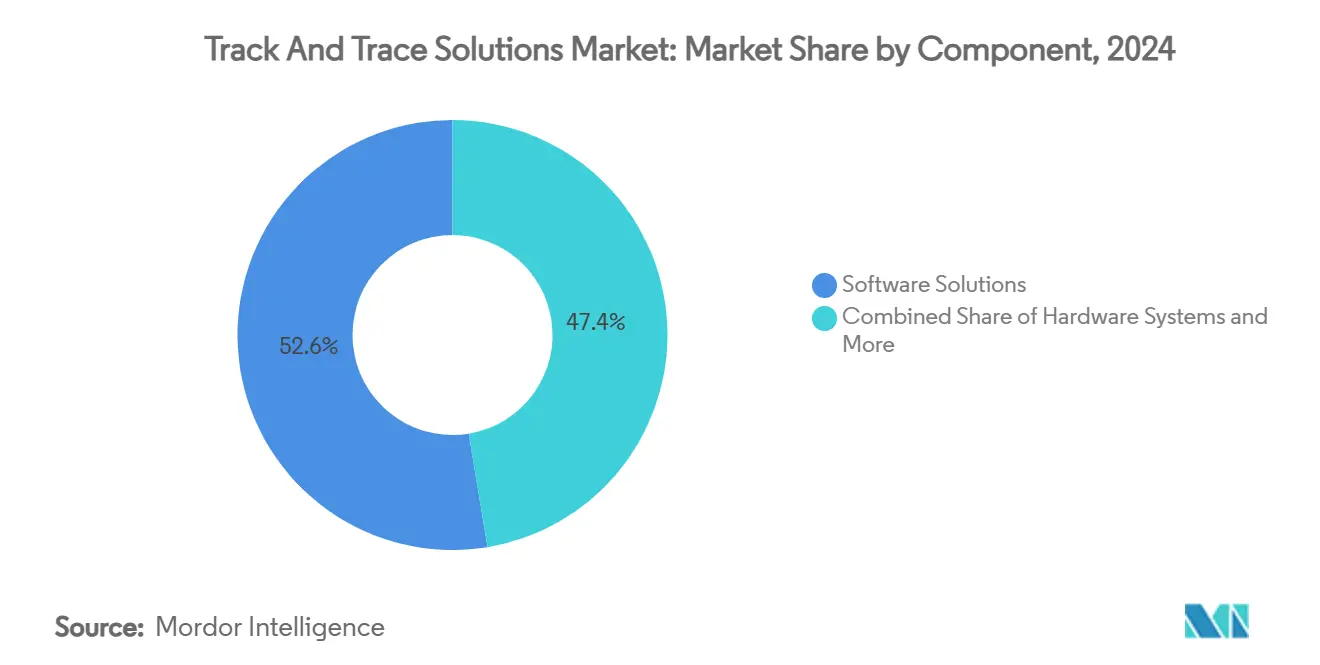
Note: Segment shares of all individual segments available upon report purchase
By Technology: RFID Gains Momentum Despite Barcode Dominance
Barcodes held a commanding 55.76% track and trace solutions market share in 2024, yet RFID solutions are forecast to expand at 9.90% CAGR until 2030, closing the gap steadily. Pharmaceutical warehouses, eager to cut manual scans, now pilot mixed tagging schemes in which high-value biologics carry RFID while generics retain 2D codes, demonstrating a hybrid approach that balances cost and capability. Real-time location data from RFID pallets feeds WMS algorithms that slash pick times, a benefit that quietly offsets tag costs in large distribution centers.
The resilience of barcodes stems from ubiquitous scanners and consistent regulatory acceptance, keeping the technology relevant for the foreseeable future. However, the falling price of passive UHF inlays suggests that the inflection point for wider RFID adoption is drawing nearer. As proof, several national health services request RFID for hospital logistics, creating a pull effect back up the supply chain. This developing preference nudges packaging-line OEMs to embed RFID tunnels in standard equipment offerings.
By Application: Aggregation Solutions Gaining Strategic Importance
Aggregation solutions accounted for a smaller base in 2024 yet are forecast to register a 9.77% CAGR, driven by the logistical efficiency of linking unit identifiers to bundle, case, and pallet hierarchies. Warehouse managers confirm that case aggregation halves receiving times because cartons can be scanned without breaching seals, freeing labor for value-added tasks. Meanwhile, bottle serialization retains dominance in unit-level coding, chiefly in North American production, where regulatory frameworks align with bottle formats, underscoring region-specific packaging preferences.
Blister serialization thrives in Europe and parts of Asia, where patient adherence packaging is prevalent, suggesting that packaging lineage decisions hinge on local dispensing habits. Bundle aggregation is emerging as an intermediate step that balances throughput with data granularity, especially for high-mix lines. An ancillary benefit of aggregation is improved recall precision, which narrows the scope of market withdrawals and protects brand equity.
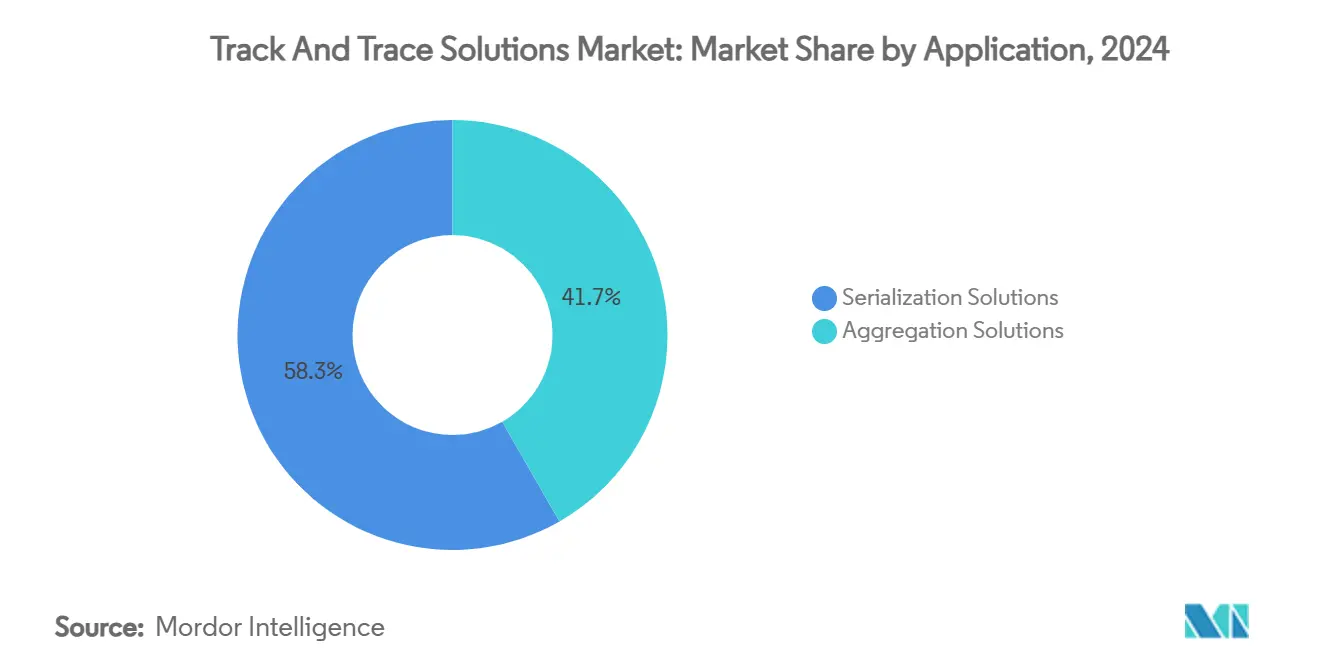
By End User: Medical Device Manufacturers Accelerate Adoption
Medical device firms held a smaller share yet are expected to grow at 8.51% CAGR, riding the global rollout of Unique Device Identification rules. Device makers see serialization as an entry ticket to tender eligibility in hospitals that rely on UDI databases to vet suppliers, highlighting compliance as a sales enabler. The Track & Trace Solutions industry thus expands beyond pharmaceuticals, diversifying vendor revenue streams and sharpening the focus on flexible data models.
Pharmaceutical manufacturers still command 40.09% of track and trace solutions market size in 2024, underlining the sector’s historic roots in drug compliance. However, the structural shift toward outsourced manufacturing shifts decision power to contract organizations, which often require interoperable systems that can satisfy multiple brand-owner templates. Distributors and wholesalers add verification layers at inbound docks, reinforcing the importance of aggregation data in high-volume settings.
Geography Analysis
North America, with 42.24% Track & Trace Solutions market share in 2024, remains the largest region because of the Drug Supply Chain Security Act that mandates unit-level traceability by August 2025[2]FDA Staff, “21 CFR Part 801 Subpart B — Labeling Requirements for Unique Device Identification,” eCFR, ecfr.gov. A notable consequence is that even small generics firms accelerate projects to avoid supply interruptions, which inflates near-term demand for validation services. The region’s mature electronic health-record infrastructure enables linkage between serialization data and clinical outcomes, providing a feedback loop that informs value-based contracting. This linkage also stimulates analytics investments by insurers aiming to verify adherence in specialty therapies. Large-scale wholesalers integrate serialization with robotics, reducing manual case handling and reshaping labor allocation across distribution centers.
Asia-Pacific shows the fastest trajectory at a forecast 10.29% CAGR, underpinned by aggressive anti-counterfeit campaigns in China and export incentives in India. Governments often couple local content rules with traceability grants, encouraging domestic IT firms to partner with global solution providers. Multinational manufacturers, confronted with compressed timelines, select configurable cloud platforms that can flip on country modules as rules mature. The same architecture supports language localization, a subtle yet critical success factor across a linguistically diverse region. Rapid e-commerce expansion forces regulators to tighten parcel-level verification, injecting further urgency into adoption.
Europe retains a significant position due to the mature Falsified Medicines Directive, which pushes verification down to the pharmacy counter. National medicine verification organization databases, already operational, anchor a dense scanning network that covers nearly every dispensing point. Manufacturers adapt by embedding tamper-evident seals on cartons, a design choice that raises consumer expectations globally. The region’s next focus is environmental sustainability, and stakeholders explore how serialization data can support carbon-footprint reporting, demonstrating the multi-dimensional potential of track and trace infrastructure.

Competitive Landscape
The top five providers collectively hold a significant market share in track and trace solutions, leaving a sizable opportunity for specialists who address regional requirements or niche technologies. Large vendors expand through bolt-on acquisitions that fill capability gaps in inspection, RFID tagging, or analytics, a strategy that compresses time-to-market for integrated suites. However, software-native challengers leverage cloud multi-tenant efficiency to undercut the maintenance costs of legacy on-prem systems, shifting the competitive basis toward speed of adaptation rather than breadth of catalog.
Data-driven differentiation is now front and center, with leading platforms anonymizing vast transaction logs to benchmark performance, a service that smaller rivals struggle to replicate. Customers recognize this network effect and increasingly treat serialization vendors as strategic collaborators rather than commodity suppliers. As evidence, long-term master service agreements now bundle joint innovation roadmaps, reflecting shared interest in monetizing data beyond compliance.
Regulatory know-how has become as pivotal as technology, causing solution providers to staff policy liaison teams that monitor draft legislation and feed requirements directly into product sprints. This consultative competency improves win rates in multi-country tenders where legal interpretation can sway total cost of ownership. Smaller regional players therefore court alliances with legal advisory firms to remain credible during RFP evaluations, signaling a convergence of legal and technical services within the competitive arena.
Track And Trace Solutions Industry Leaders
-
Antares Vision S.p.A
-
Zebra Technologies Corporation
-
VISIOTT
-
TraceLink Inc.
-
OPTEL Group
- *Disclaimer: Major Players sorted in no particular order
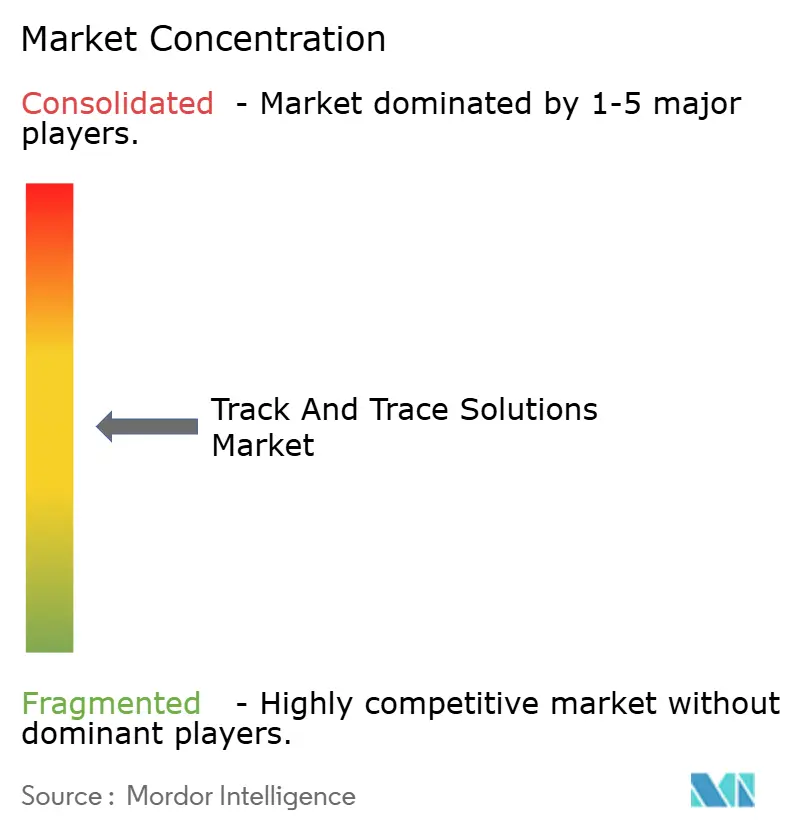
Recent Industry Developments
- January 2025: TraceLink reported adding 231 new customers in 2024 and upgraded its OPUS platform with no-code orchestration and an AI assistant, which accelerates digitalization for mid-tier manufacturers. The move underscores the pivot to customer-configurable SaaS that democratizes advanced functionality.
- January 2025: Antares Vision Group highlighted new inspection and traceability lines at Pharmapack, signaling its intent to merge hardware innovation with software analytics. The company positions the release as a step toward complete digital factory enablement.
- January 2025: Systech unveiled a semi-automated aggregation module at Pharmapack, offering a quicker upgrade path for plants with constrained floor space. Early pilot users report smoother bundle-to-case mapping, which reduces manual touches.
Research Methodology Framework and Report Scope
Market Definitions and Key Coverage
Our study defines the track and trace solutions market as all software, hardware, and associated managed services that assign, capture, and transmit unique, item-level identifiers, primarily 2-D barcodes and RFID tags, along regulated and discretionary supply-chain touchpoints, enabling end-to-end product lineage verification, recall execution, and diversion analytics. According to Mordor Intelligence, values reflect revenue earned by original solution providers from new system sales, integration fees, and recurring support in healthcare, food, consumer, and industrial sectors during calendar year 2025.
Scope Exclusions: aftermarket coding fluids, generic WMS without serialization modules, and pure blockchain platforms sitting outside packaged track and trace suites are excluded.
Segmentation Overview
- By Component
- Hardware Systems
- Printing & Marking Equipment
- Monitoring & Verification Systems
- Labeling & Tamper-evident Solutions
- Other Hardware
- Software Solutions
- Plant-level Management Suites
- Line Controller Software
- Bundle / Pallet Tracking Software
- Enterprise & Cloud Platforms
- Professional & Managed Services
- Hardware Systems
- By Technology
- Barcode / 2-D DataMatrix
- RFID & NFC
- Advanced IoT Sensors & BLE Beacons
- By Application
- Serialization Solutions
- Bottle Serialization
- Blister & Strip Serialization
- Carton & Case Serialization
- Data-Matrix / QR Serialization
- Aggregation Solutions
- Bundle Aggregation
- Case Aggregation
- Pallet Aggregation
- Serialization Solutions
- By End User
- Pharmaceutical Manufacturers
- Contract Manufacturing & Packaging Organizations (CMOs/CPOs)
- Medical Device Manufacturers
- Healthcare Distributors & Wholesalers
- Other Life-science Stakeholders (OTC, Nutraceuticals, Cosmetics, Legal Cannabis)
- Geography
- North America
- United States
- Canada
- Mexico
- Europe
- Germany
- United Kingdom
- France
- Italy
- Spain
- Rest of Europe
- Asia-Pacific
- China
- Japan
- India
- South Korea
- Australia
- Rest of Asia-Pacific
- Middle East and Africa
- GCC
- South Africa
- Rest of Middle East and Africa
- South America
- Brazil
- Argentina
- Rest of South America
- North America
Detailed Research Methodology and Data Validation
Primary Research
Mordor analysts interviewed serialization software architects, packaging-line OEM engineers, hospital supply-chain heads, and pharmaceutical quality officers across North America, Europe, and Asia-Pacific. These discussions tested penetration assumptions, average selling prices, and upgrade cadence; they provided real-time feedback on emerging IoT sensor bundles that secondary literature rarely covers.
Desk Research
We start by mapping the regulatory backbone, US FDA DSCSA implementation updates, EU Falsified Medicines Directive notices, GS1 standards releases, and customs shipment records from UN Comtrade, to size addressable compliance demand. Public disclosures from agencies such as the WHO counterfeit alerts database and the European Medicines Verification System, together with trade association white papers (Healthcare Distribution Alliance, AIM-NA), help our analysts benchmark technology adoption curves.
Commercial intelligence from D&B Hoovers, shipment micro-data scraped through Volza, and device installation counts cited in FDA 510(k) summaries refine vendor universe estimates before numbers move into modeling. The sources above illustrate our desk research grid; several additional open and paid repositories were also reviewed to validate figures and close information gaps.
Market-Sizing & Forecasting
A top-down reconstruction rooted in regulated drug and food production volumes, average label density per SKU, and plant-level serialization rollout rates sets the initial baseline, which is then corroborated with selective bottom-up checks such as sampled ASP by module multiplied by installed base counts. Variables including line throughput (packs/hour), RFID cost per tag erosion, cloud licensing mix, counterfeit incident frequency, and regional compliance deadlines feed a multivariate regression that projects demand through the forecast period. Where supplier roll-ups lack completeness, weighted interpolation guided by median ASP dispersion bridges gaps before totals are locked.
Data Validation & Update Cycle
Outputs undergo three-layer variance screening, peer review, and anomaly flags against independent import duty collections and vendor 10-K disclosures. Reports refresh each year, and we trigger mid-cycle updates when new legislation or major recalls materially shift model drivers, ensuring clients receive our latest vetted view.
Why Mordor's Track And Trace Solutions Baseline Commands Reliability
Published estimates often diverge because firms choose different product mixes, regulatory cut-off dates, and refresh speeds.
Key gap drivers include whether aggregation modules are counted with serialization cores, the aggressiveness of cloud migration assumptions, currency conversion timing, and how fast barcode to RFID substitution is modeled.
Benchmark comparison
| Market Size | Anonymized source | Primary gap driver |
|---|---|---|
| USD 3.51 B (2025) | Mordor Intelligence | - |
| USD 6.96 B (2025) | Global Consultancy A | Broader inclusion of packaging line peripherals and aftermarket inks inflates base |
| USD 8.79 B (2025) | Industry Journal B | Uses aggressive RFID adoption curve and assumes universal cloud licensing from year one |
The comparison shows how carefully bounded scope, conservative uptake rates, and an annual refresh cadence let Mordor deliver a balanced, transparent market baseline that decision-makers can trace back to clearly documented variables and reproducible steps.
Key Questions Answered in the Report
Why are software solutions gaining a larger share of the Track & Trace Solutions industry?
Companies increasingly seek analytics and collaboration features that convert compliance data into operational value, which software modules deliver better than hardware alone.
What is driving the strong growth of the Track & Trace Solutions market?
Stringent global regulations, rising counterfeit threats, and the move toward cloud-based platforms collectively propel consistent demand.
How does aggregation differ from serialization in pharmaceutical traceability?
Serialization assigns a unique code to individual units, while aggregation links those units to their parent bundles, cases, and pallets, speeding logistics checks.
Which region will grow fastest through 2030 in the Track & Trace Solutions market?
Asia-Pacific is expected to post the highest CAGR because of stringent anti-counterfeit initiatives and expanding pharmaceutical exports.
How are RFID technologies influencing the Track & Trace Solutions market size outlook?
RFID’s ability to enable non-line-of-sight reads and richer data sets is driving adoption in high-value product categories, supporting above-market growth for the segment.
What role do cybersecurity considerations play in system selection?
Buyers now evaluate vendors on zero-trust architecture and data-tokenization capabilities, reflecting heightened concern over intellectual property protection in cloud deployments.
Page last updated on:
